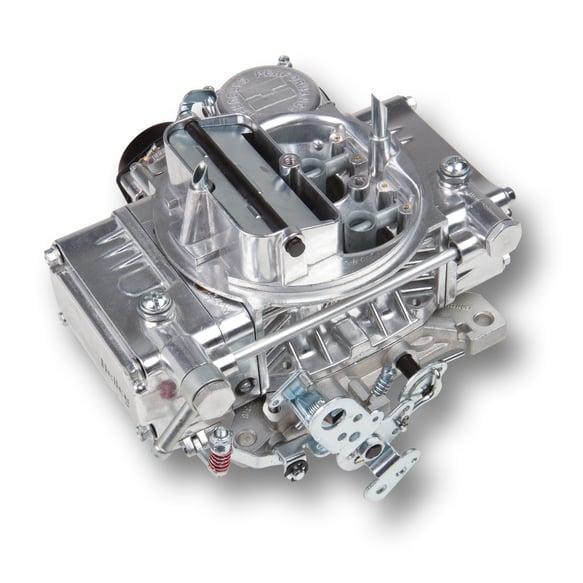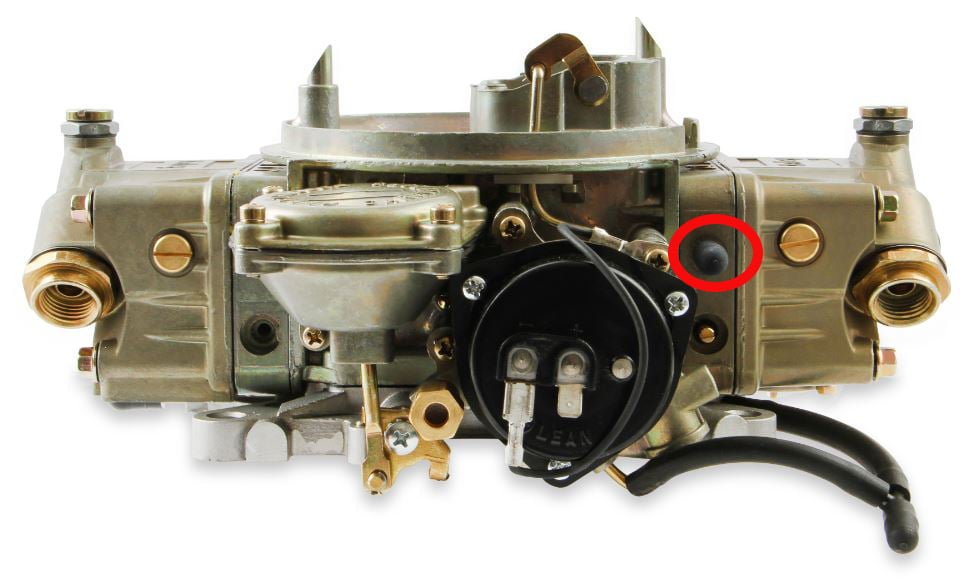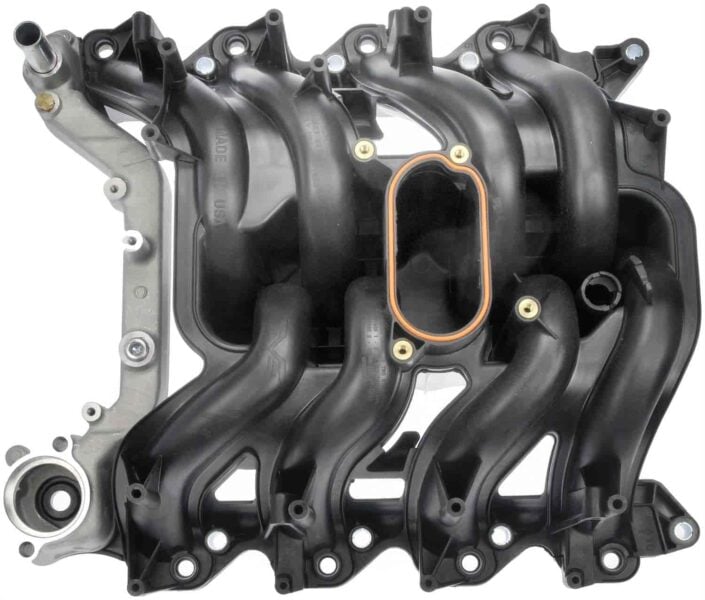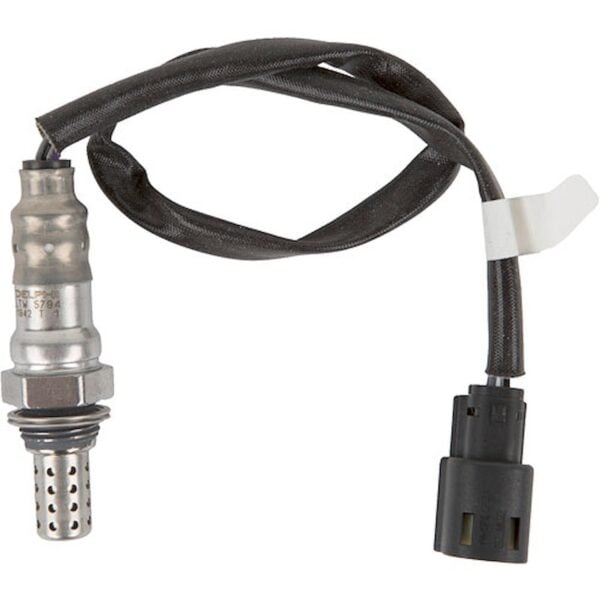Sign up now to join the JEGS email newsletter and be the first to learn about new products, special deals and e-mail only offers!


Answer: The carburetor CFM is a very critical choice in your build. Too large will cause low RPM issues and a rich condition. Too small will restrict engine performance at high RPM. Another part of the calculation for correct carburetor CFM size involves the engine's volumetric efficiency or "VE". As is it not easy to know exactly what your engine's VE percentage is, you will need to make an educated guess. We advise that your guess be "conservative" and realistic for the calculation. Most street engines have a volumetric efficiency of around 85%. A VE of 95% is considered extremely well-flowing. A highly-developed match of the intake passages, combustion chambers, exhaust passages, and valves through planning, machine work, and testing can put an engine at 100%-110%, such as in NHRA Top Fuel, Funny Car, and Pro Stock applications.
A simple formula is commonly used by our techs to select the proper CFM:
(Cubic Inches of Engine X Max Shift RPM) / 3456 (the number of cubic inches in a cubic foot (1728) times the number of revolutions (2) for a 4-stroke engine to fill and empty all of its cylinders) x VE(Volumetric Efficiency) = Maximum Carburetor CFM Required
For example, (350ci X 6500RPM)/3456 x .85 (85%)=559.53 CFM (a 600 CFM would be the closest size for this application)
Below is a calculator to make everything much easier:
Answer: For streetcars, the vacuum secondary carburetor works best on most cars with an automatic transmission. They are more forgiving than a mechanical secondary because they work by sensing engine load. The mechanical secondary carb is best on a lighter car with a radical camshaft, a lower gear, and manual transmission. A mechanical secondary is the best choice for most high RPM race purposes.


Answer: Actually, you can't. CFM (cubic feet per minute) refers to the airflow through the main venturi of the carburetor. Simple re-jetting will not change the carburetor CFM.
Answer: Fuel in the oil can be caused by several conditions including a ruptured fuel pump diaphragm, incorrect fuel line hook-up, and carburetor flooding. If the problem is carb flooding, check the following: Fuel pressure should not exceed 6.5 psi. The float level should be verified. Verify needle & seats are free of any debris and have a smooth range of operation and travel. Verify floats are free of any fluid by shaking the float or submerging it in a safe, non-flammable fluid. Lastly, a fuel smell in oil can be caused by an excessively rich tuned carburetor.
Answer: The most common answer is that has to be tuned to match your engine. Rarely will a new carburetor work right out of the box and some tuning will be required. The adjustment method can differ with the carburetor type, but the general progression is the same. Use the follow guide for direction and refer to the carburetor owners manual for specific methods. First, you will need to be sure the engine is warm and in good working order and be sure that the float level and fuel pressure are within the specified ranges. The first circuit to tune will the idle circuit. This requires the use of a vacuum gauge to adjust the idle mixture screws tuning to maximum vacuum. The second circuit to tune is the intermediate circuit. The intermediate circuit is the most common circuit that needs to be tuned. This circuit is most responsible for off idle hesitations or stumbles. As mentioned, each carburetor is different, but this circuit typically involves a mechanical lever that compresses an accelerator pump diaphragm through a discharge nozzle. In almost all types of carburetors, the mechanical pump action is adjustable and so is the orifice size of which the fuel is dispersed. Last is secondary jetting/ tuning. On most vacuum secondary carburetors, the rate at which the secondaries open is adjustable. It may be advantageous to open the secondaries earlier or later. Road testing and trial and error is the most common way to come to this determination. Lastly, strict jetting is fairly straight forward. If the engine runs lean at wide-open throttle it will need to be jetted up, if rich, jetted down. Spark plug reading is a very common method to determine WOT tune, some more advanced tuners will use a specialized gauge that reads fuel mixture from the exhaust pipe.
Sign up now to join the JEGS email newsletter and be the first to learn about new products, special deals and e-mail only offers!

Answer: Check for correct choke operation and adjustment. Make sure that the fast idle cam is not causing this. Verify the throttle armrests on the idle speed screw. It is important to verify throttle linkage, and or throttle blades are not binding and have a free range of operation. The throttle return spring should be correctly located and adjusted. In most cases, the return spring should be positioned on the top of the throttle arm forward. Make sure all of the vacuum ports on the carburetor are being utilized or blocked off. Check for any vacuum leaks, when the idle mixture screw(s) are all adjusted inward, the engine should die. If the engine remains running, this is a key indicator of a vacuum leak.
Answer: Typically an electric choke will involve 2 wires. The first and most critical is the, often red, positive voltage wire. This is to be connected to a switched 12-volt ignition source that provides power only when the ignition key is on. Connecting this wire to a full-time 12-volt wire will cause damage to the choke and it will not work properly. The second wire is the, often black, ground wire. Simply connect this to chassis ground. Most manufacturers pre-terminate this wire to the carburetor base or body. This is ok as long as your engine ground is present and functioning.
Answer: It is critical for your vacuum advance to be hooked to a timed port. If this is connected to a full-time vacuum port, it will remain advanced full time and you will lose the functionality of the vacuum advance feature. The timed port on a Holley design carburetor is located high on the side of the primary metering block. On the Carter AFB/ Edelbrock design, it is the higher of the two small vacuum ports on the front of the carburetor. Quadrajet can differ with design, but their timed port is typically placed mid-level on the rear right side.


Answer: Most commonly this is a float level issue. Confirm float level and retest the cause of the stall. In racing applications, specialized floats are available for extreme versions of these situations. Also, the use of jet extensions may be required in the secondary side of a carburetor for extremely hard accelerations such as a drag car.
Answer: First off, make sure you have the correct CFM for your application, the carburetor is installed on the engine and the idle mixture screws are properly adjusted. You can always make your carburetor leaner, but this will not always improve gas mileage. Since every engine is different, there is no way of knowing how much of an effect leaning down the carburetor will have on your engine. You can refer to your carburetor owner's manual and the calibration suggestions inside to lean down the carb. Start off light, but keep an eye on the plugs to make sure you aren't taking it too lean. The most efficient fuel mixture typically results in a light to medium tan color on the internal porcelain area of the spark plug. White or gray porcelain indicates a lean condition, black or fuel soaked porcelain indicates a rich condition.




